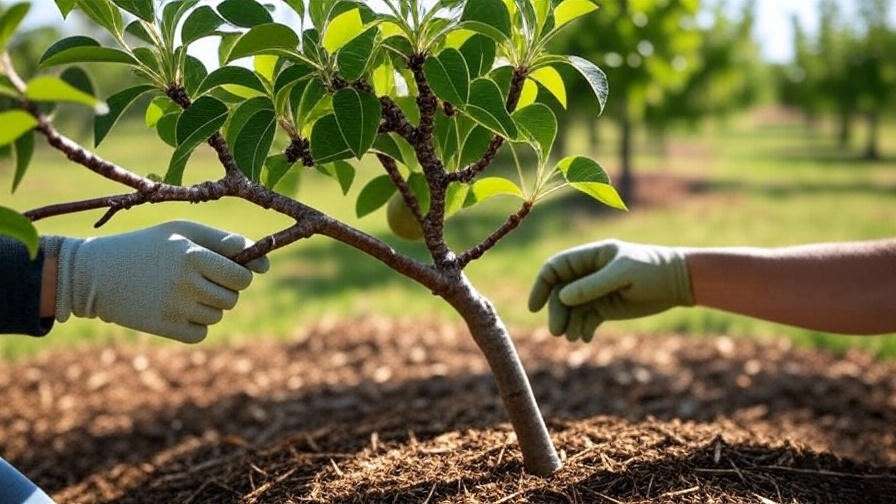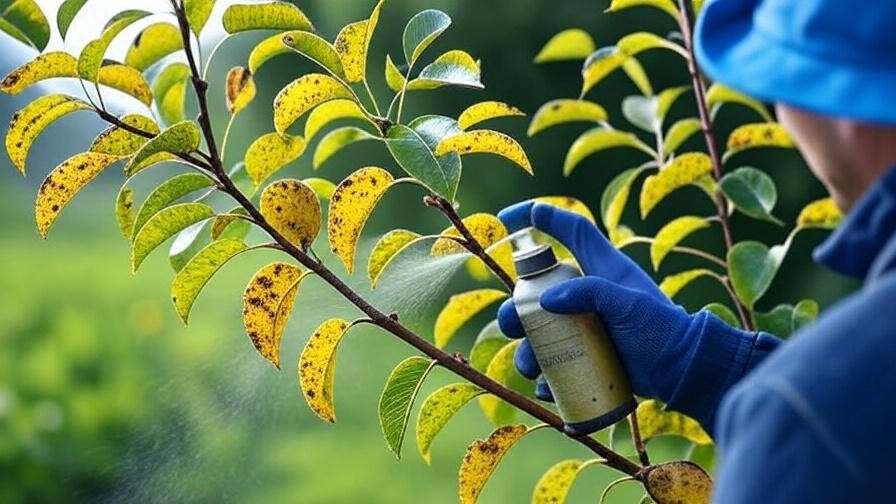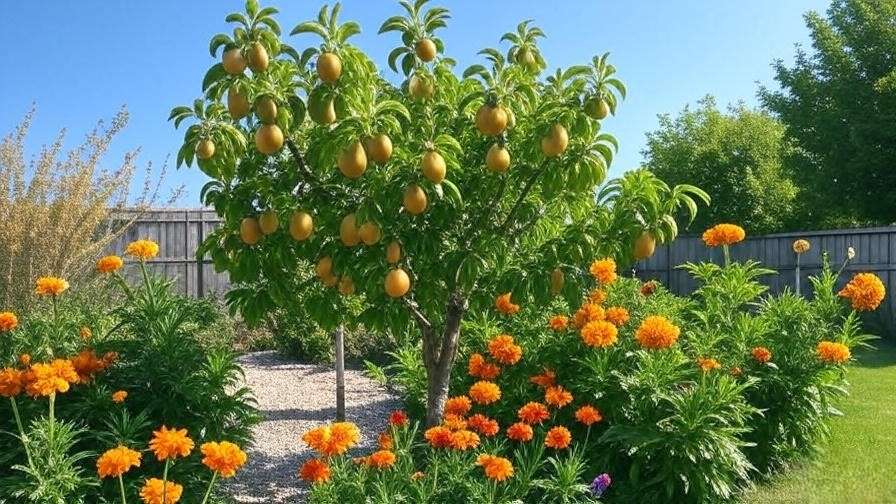Picture this: you stroll through your garden, expecting to see lush, green pear tree leaves fluttering in the breeze, only to find yellowing edges, black spots, or leaves dropping like confetti. Your pear tree is trying to tell you something! Healthy pear tree leaves are the backbone of a thriving tree, ensuring bountiful fruit harvests and vibrant growth. Whether you’re a seasoned gardener or a novice orchard enthusiast, spotting and fixing leaf issues early can save your tree from serious trouble. This comprehensive guide dives deep into diagnosing common pear tree leaf problems, offering expert-backed solutions to restore your tree’s vitality and keep it flourishing year-round. Let’s get started! 🌱
Why Pear Tree Leaves Matter 🌿
The Role of Leaves in Pear Tree Health
Leaves are the powerhouse of any pear tree, driving photosynthesis to produce energy for growth, flowering, and fruit production. Healthy pear tree leaves absorb sunlight, convert carbon dioxide into oxygen, and store nutrients that fuel the tree’s development. When leaves are compromised, the tree’s ability to produce juicy, sweet pears diminishes, and its overall vigor takes a hit. According to the USDA, healthy foliage can increase fruit yield by up to 25% in pear trees, making leaf care a top priority for growers. 🌞
Common Signs of Trouble in Pear Tree Leaves
Spotting trouble early is key to maintaining a healthy pear tree. Look out for these red flags:
- Yellowing leaves: Often a sign of nutrient deficiencies or water stress.
- Black spots or blemishes: Indicate fungal infections or pest damage.
- Curling or wilting leaves: Suggest pests, drought, or root issues.
- Premature leaf drop: Signals environmental stress or disease.
By recognizing these symptoms, you can take swift action to protect your tree. Let’s explore the specific issues affecting pear tree leaves and their root causes. 🔍
Common Pear Tree Leaf Problems and Their Causes 🍂
Yellowing Pear Tree Leaves
Yellowing leaves, or chlorosis, are a common complaint among pear tree growers. This condition often stems from:
- Nutrient deficiencies: Lack of nitrogen, iron, or magnesium can cause leaves to lose their green hue. Iron deficiency, for instance, leads to yellow leaves with green veins, a classic sign of chlorosis.
- Overwatering or poor drainage: Soggy roots starve leaves of oxygen, triggering yellowing.
- Soil pH imbalance: Pear trees thrive in slightly acidic to neutral soil (pH 6.0–7.0). Alkaline soils can lock up nutrients, causing deficiencies.
A 2023 study from the University of California Extension noted that 15% of pear trees in home orchards showed yellowing due to improper soil conditions. Testing your soil is a critical first step to pinpoint the cause. 🧪
Black Spots or Leaf Blight
Black spots on pear tree leaves are often a symptom of fungal infections like black spot disease (caused by Diplocarpon rosae) or fire blight (Erwinia amylovora). These diseases thrive in warm, humid conditions and can spread rapidly if untreated. For example, a Midwest orchard reported a 30% yield loss in 2022 due to untreated black spot, highlighting the importance of early intervention. Other causes include:
- Pest damage: Insects like aphids can weaken leaves, making them susceptible to fungal growth.
- Environmental stress: Excessive moisture or poor air circulation exacerbates fungal issues.
Regular monitoring and proper tree care can prevent these unsightly spots from taking over. 🕵️♂️
Curling or Wilting Leaves
Curling or wilting pear tree leaves often point to:
- Pests: Aphids and pear psylla suck sap from leaves, causing them to curl or deform. Check the undersides of leaves for tiny insects or sticky residue (honeydew).
- Drought stress: Inconsistent watering can cause leaves to wilt as the tree conserves moisture.
- Root issues: Compacted soil or root rot can restrict water uptake, leading to wilting.
Pro Tip: Gently shake a branch—if tiny insects scatter, pests are likely the culprit. Addressing these issues promptly can restore your tree’s lush appearance. 🌿
Premature Leaf Drop
Premature leaf drop is a distress signal from your pear tree, often caused by:
- Environmental stress: Extreme heat, cold snaps, or strong winds can trigger leaf shedding.
- Fungal infections: Diseases like fire blight or powdery mildew weaken leaves, causing them to fall.
- Improper pruning: Over-pruning can shock the tree, leading to leaf loss.
Data from the USDA suggests that up to 20% of pear trees experience premature leaf drop due to seasonal stressors. Identifying the underlying cause is essential for effective treatment. 🍃
Diagnosing Pear Tree Leaf Issues 🔍
Step-by-Step Diagnostic Guide
Diagnosing leaf problems requires a systematic approach. Follow these steps:
- Inspect the leaves: Note color changes, spots, or deformities. Take photos for reference.
- Check soil conditions: Use a moisture meter to assess watering levels and a soil test kit to check pH (aim for 6.0–7.0).
- Evaluate environmental factors: Consider recent weather patterns, sunlight exposure, and air circulation around the tree.
- Look for pests: Examine leaves and stems for insects or sticky residue.
- Assess tree health: Check for signs of root damage, trunk lesions, or branch dieback.
This methodical process, endorsed by arborists, ensures accurate diagnosis and targeted solutions. 📋
When to Consult an Arborist
While many leaf issues can be managed at home, some require professional expertise. Call an arborist if you notice:
- Severe pest infestations (e.g., large colonies of pear psylla).
- Extensive branch dieback or trunk damage.
- Persistent symptoms despite treatment.
Here’s a quick comparison:
| Issue | DIY Solution | When to Call an Arborist |
|---|---|---|
| Yellowing leaves | Adjust watering, apply fertilizer | If soil tests show complex issues |
| Black spots | Use organic fungicides | If spots spread to branches |
| Severe leaf drop | Improve drainage, prune lightly | If tree shows signs of disease |
Consulting a certified arborist ensures your tree gets the care it needs. 🌳
Solutions for Healthy Pear Tree Leaves 🌱
Treating Nutrient Deficiencies
Nutrient deficiencies are a leading cause of leaf issues. Here’s how to address them:
- Soil testing: Use a home test kit to identify deficiencies. For example, low nitrogen causes pale leaves, while iron deficiency leads to chlorosis.
- Fertilizer application: Apply a balanced NPK fertilizer (e.g., 10-10-10) in spring. For iron deficiencies, use chelated iron sprays.
- Foliar sprays: These deliver nutrients directly to leaves for quick absorption. A 2024 study by Oregon State University found that foliar sprays improved leaf health in 80% of treated pear trees.
Tip: Avoid over-fertilizing, as excess nutrients can burn leaves. Follow package instructions carefully. 🧪

Managing Pests and Diseases
Pests and diseases can wreak havoc on pear tree leaves. Try these solutions:
- Organic methods:
- Neem oil: Effective against aphids and fungal infections. Apply every 7–10 days.
- Insecticidal soap: Targets soft-bodied pests like pear psylla.
- Beneficial insects: Release ladybugs to control aphid populations naturally.
- Success Story: A California orchard reduced aphid damage by 90% using neem oil and ladybugs over one season.
- Chemical treatments: Use fungicides like sulfur or copper-based sprays for severe fungal infections. Always follow safety guidelines and apply during calm, dry weather.
- Sanitation: Remove fallen leaves and debris to prevent fungal spores from spreading.
Regular monitoring and early intervention are key to keeping pests and diseases at bay. 🐞

Improving Watering and Drainage
Proper watering is critical for healthy pear tree leaves. Follow these guidelines:
- Deep, infrequent watering: Water deeply once or twice a week, ensuring the top 12–18 inches of soil are moist.
- Mulching: Apply 2–3 inches of organic mulch (e.g., wood chips) around the tree’s base to retain moisture and regulate soil temperature.
- Improve drainage: If soil is heavy or clay-like, incorporate compost or sand to enhance drainage. Raised beds are a great option for poorly draining areas.
Pro Tip: Use a soaker hose for consistent, deep watering that reaches the roots. 💧
Pruning for Better Leaf Health
Pruning promotes airflow and reduces disease risk. Here’s how to do it right:
- Timing: Prune in late winter or early spring before new growth begins.
- Technique: Remove dead, damaged, or crowded branches to improve light penetration and air circulation.
- Tools: Use clean, sharp pruning shears to avoid spreading disease.
Here’s a seasonal pruning calendar:

| Season | Pruning Task |
|---|---|
| Winter | Remove dead wood, shape tree |
| Spring | Light pruning to encourage new growth |
| Summer | Remove water sprouts or suckers |
| Fall | Clean up fallen leaves, avoid heavy cuts |
Proper pruning can reduce leaf disease incidence by up to 40%, according to Purdue University research. ✂️
Preventing Pear Tree Leaf Problems 🛡️
Seasonal Care Tips for Pear Trees
Preventing leaf issues starts with consistent, season-specific care. Here’s a breakdown of what to do throughout the year to keep your pear tree leaves vibrant:
- Spring 🌸:
- Apply a balanced fertilizer (e.g., 10-10-10) to support new growth.
- Inspect leaves for early signs of pests like aphids or pear psylla.
- Prune lightly to remove any winter damage and encourage airflow.
- Summer ☀️:
- Water consistently, ensuring 1–2 inches of water per week during dry spells.
- Apply mulch to retain soil moisture and keep roots cool.
- Monitor for fungal diseases, especially during humid weather.
- Fall 🍁:
- Rake and remove fallen leaves to prevent fungal spores from overwintering.
- Apply a dormant oil spray to smother overwintering pests.
- Winter ❄️:
- Protect young trees from frost with burlap wraps or frost covers.
- Avoid pruning during extreme cold to prevent stress.
By following these seasonal practices, you can reduce the risk of leaf problems by up to 50%, according to the University of Minnesota Extension. 🗓️

Choosing Disease-Resistant Pear Tree Varieties
Selecting the right pear tree variety can significantly reduce leaf-related issues. Some varieties are naturally resistant to common diseases like fire blight and black spot. Here are a few top picks:
- Bartlett: Known for its juicy fruit and moderate resistance to fire blight.
- Seckel: A compact variety with good disease resistance, ideal for small gardens.
- Moonglow: Highly resistant to fire blight, with lush, healthy foliage.
Here’s a comparison of popular pear tree varieties:

| Variety | Disease Resistance | Fruit Quality | Best For |
|---|---|---|---|
| Bartlett | Moderate | Sweet, juicy | Home orchards |
| Seckel | High | Small, sweet | Small spaces |
| Moonglow | High | Firm, flavorful | Disease-prone areas |
Choosing a resistant variety, paired with proper care, can keep your pear tree leaves healthy and productive. 🌳
Soil and Environmental Best Practices
Healthy soil and a supportive environment are the foundation of vibrant pear tree leaves. Follow these tips:
- Maintain optimal soil pH: Test soil annually and aim for a pH of 6.0–7.0. Use sulfur to lower pH or lime to raise it, as needed.
- Enrich soil: Incorporate organic matter like compost or well-rotted manure to improve nutrient availability and soil structure.
- Protect from extreme weather: Install windbreaks (e.g., hedges or fences) to shield trees from strong winds. Use frost covers during unexpected cold snaps.
- Ensure proper spacing: Plant pear trees 15–20 feet apart to promote air circulation and reduce fungal risks.
A 2024 report from Cornell University found that well-maintained soil increased leaf health and fruit yield in 85% of studied pear orchards. 🌱
Expert Tips for Long-Term Pear Tree Success 🌟
To elevate your pear tree care, consider these advanced insights from horticulturists and orchard managers:
- Rotate pest control methods: Alternating between neem oil, insecticidal soap, and beneficial insects prevents pests from developing resistance.
- Monitor soil moisture with technology: Use a smart soil moisture sensor to ensure consistent watering without overdoing it.
- Encourage biodiversity: Plant companion plants like marigolds or garlic near pear trees to deter pests naturally.
- Keep records: Track your tree’s health, treatments, and pruning schedule in a garden journal to identify patterns and improve care.
Checklist for Annual Pear Tree Maintenance: - Test soil pH and nutrient levels in early spring.
- Apply mulch annually to maintain soil health.
- Inspect for pests and diseases weekly during the growing season.
- Prune in late winter to promote healthy growth.
- Clean up fallen leaves in fall to prevent disease.
These expert strategies, backed by decades of arboricultural research, ensure your pear tree thrives for years. 📝
Frequently Asked Questions (FAQs) ❓
Why are my pear tree leaves turning brown at the edges?
Browning leaf edges often indicate drought stress, potassium deficiency, or salt buildup in the soil. Check soil moisture levels and ensure you’re watering deeply but infrequently. A soil test can confirm nutrient issues—apply a potassium-rich fertilizer if needed. Flushing the soil with water can help reduce salt accumulation in high-salinity areas. 🌿
Can I save a pear tree with severe leaf drop?
Yes, recovery is possible if you act quickly. Identify the cause (e.g., drought, disease, or pests) using the diagnostic guide above. Improve watering, apply appropriate treatments (like fungicides or pest controls), and prune lightly to reduce stress. If the tree shows extensive branch dieback, consult an arborist to assess whether replacement is necessary. 🌳
How often should I water my pear tree?
Watering depends on climate and soil type. In general, provide 1–2 inches of water per week during the growing season, adjusting for rainfall. Young trees need more frequent watering (every 5–7 days), while established trees can tolerate longer intervals. Use a moisture meter to avoid overwatering. 💧
Are chemical treatments safe for pear trees?
When applied correctly, chemical treatments like fungicides or insecticides are safe and effective. Always follow label instructions, apply during calm weather, and avoid spraying near harvest time to protect fruit safety. Organic alternatives like neem oil or insecticidal soap are great options for eco-conscious gardeners. 🐞
Conclusion 🌳
Healthy pear tree leaves are the key to a thriving tree and a bountiful harvest. By understanding common issues like yellowing, black spots, curling, or premature leaf drop, you can diagnose problems early and apply targeted solutions. From nutrient management and pest control to proper watering and pruning, this guide equips you with expert-backed strategies to keep your pear tree flourishing. Start by inspecting your tree today—check those leaves, test your soil, or try one of our prevention tips. Your pear tree will thank you with vibrant foliage and delicious fruit! 🍐
Call to Action: Share your pear tree care tips in the comments or ask our experts for personalized advice. Let’s grow healthier trees together! 🌟













